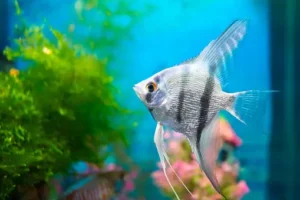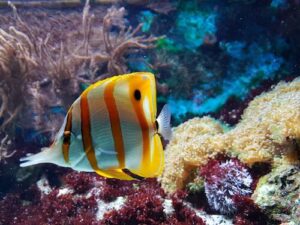Introduction To Angelfish: Exploring the Beauty and Elegance!

Angelfish known for their captivating beauty and graceful demeanor, are a popular choice among aquarium enthusiasts and marine life admirers. Belonging to the cichlid family, the angelfish (Pterophyllum spp.) stands out for its distinctive triangular shape, trailing fins, and striking color patterns. These captivating creatures are native to the freshwater rivers and streams of South America, primarily found in regions such as the Amazon Basin, Orinoco Basin, and various other tributaries.
One of the most intriguing aspects of angelfish is their incredible range of colors and patterns. From the classic silver with black stripes to the mesmerizing veil and marble varieties, their showcase a remarkable diversity that appeals to aquarists seeking to create visually stunning underwater landscapes. Their extended fins, which resemble delicate trailing threads, add an air of elegance to their appearance as they glide through the water with an almost ethereal quality.
They are not only admired for their aesthetic appeal but also for their intriguing behaviors. These fish exhibit a hierarchy-based social structure and can display territorial instincts. Observing their interactions provides insights into their complex dynamics, making them subjects of fascination for those studying aquatic behavior.
When considering angelfish as aquarium pets, it’s crucial to understand their specific care requirements. Their tank setup should replicate their natural habitat, featuring ample vertical space and places to seek shelter. A balanced diet is essential, including high-quality flakes, pellets, and occasional treats like live or frozen foods to maintain their health and vibrant colors.
Breeding angelfish can be a rewarding endeavor for experienced hobbyists. However, it demands a deeper understanding of their reproductive habits, including courtship rituals and raising the fry (young fish). Successfully raising angelfish fry requires careful attention to water conditions, feeding regimes, and protection from potential predators.
In this exploration of their, we will delve into their various species, color variations, behaviors, and essential care guidelines. Whether you are an avid aquarist or simply captivated by the aquatic world’s beauty, they are sure to enchant and enrich your understanding of the intricate ecosystems thriving beneath the water’s surface.
Angelfish Species Diversity:

They members of the cichlid family, are renowned for their striking appearance, graceful behavior, and captivating presence in freshwater aquariums. This group encompasses a diverse range of species, each distinguished by its own set of characteristics, color patterns, and behaviors. From the iconic Pterophyllum scalar to lesser-known species like Pterophyllum altum, their family showcases is a fascinating array of adaptations that have captivated aquarists and biologists alike.
One of the most recognizable angelfish species is Pterophyllum scalar, often referred to as the “common angelfish.” It boasts a laterally compressed body, elongated dorsal and anal fins, and a distinctive triangular shape. The color variations within this species are remarkable, featuring shades of silver, black, white, and various combinations thereof. Another species, Pterophyllum altum, stands out with its tall body, extended dorsal and anal fins, and unique shape adapted for life in flowing waters.
Their species also display intriguing behaviors. They are known for their territorial nature, which can lead to hierarchical disputes within aquariums. Observing their courtship rituals, during which potential mates perform intricate dances and displays, is a true delight for aquarium enthusiasts. Furthermore, some species are more social and cooperative in group settings, while others prefer solitary lifestyles.
In the wild, angelfish inhabit various freshwater habitats across South America, such as the Amazon River basin and its tributaries. This wide distribution has contributed to the evolution of distinct characteristics among different species. For example, they are from areas with swift currents have developed streamlined bodies to navigate effectively.
Maintaining their species in aquariums requires a keen understanding of their specific needs. Water temperature, pH levels, and tank dimensions should mimic their natural habitats. By catering to these requirements, aquarists can ensure the well-being and longevity of their angelfish companions.
Aquarium Care for Angelfish:

Caring for their in an aquarium can be a rewarding and visually captivating experience. These graceful and elegant freshwater fish are known for their distinctive triangular shape, striking colors, and flowing fins. To ensure their well-being and vibrant appearance, proper aquarium care is essential.
Aquarium Setup:
Start by choosing an adequately sized tank, as they can grow to be around 6 inches tall. A tank of at least 20 gallons is recommended for a pair of angelfish. Provide ample vertical swimming space as well as hiding spots, like plants, rocks, and driftwood, to mimic their natural habitat.
Water Conditions:
Maintaining water quality is crucial. Keep the water temperature between 75-82°F (24-28°C) and maintain a slightly acidic to neutral pH level around 6.0-7.5. Regularly test water parameters and perform water changes to prevent ammonia and nitrite buildup.
Filtration and Aeration:
A good filtration system is essential to remove waste and toxins from the water. They prefer calm water, so avoid strong currents that can stress them. Aeration helps maintain proper oxygen levels and promotes a healthy environment.
Tank Mates:
When selecting tank mates, consider the peaceful nature of angelfish. Suitable tank mates include tetras, corydoras catfish, and other peaceful community fish.
Feeding:
A varied diet is vital for angelfish. Provide high-quality flake or pellet food supplemented with frozen or live foods like brine shrimp, bloodworms, and daphnia. This diverse diet supports their health, coloration, and overall vitality.
Social Dynamics:
Angelfish are generally social but can become territorial during breeding. Keep them in pairs or groups to prevent isolation, which can lead to stress. However, avoid overcrowding the tank.
Breeding Considerations:
If you’re interested in breeding angelfish, provide flat surfaces like large leaves or slate for them to lay their eggs on. Once a pair forms a bond, they may become aggressive towards other fish, so be prepared to separate them if necessary.
Top 10 Best Guard Dog Breeds to Protect Your House and Family
Breeding Angelfish:

Breeding angelfish can be a rewarding and fascinating endeavor for aquarium enthusiasts. These graceful and elegant fish are known for their distinctive triangular bodies, long fins, and vibrant colors, making them a popular choice among aquarists. Breeding angelfish not only offers the opportunity to observe the intriguing process of reproduction but also contributes to the conservation of various angelfish species.
Preparation and Selection:
Before embarking on the breeding journey, it’s crucial to have a suitable environment ready. A spacious tank with plenty of hiding spots, plants, and smooth surfaces for egg attachment is essential. Choosing healthy adult angelfish is the next step, preferably a pair that exhibits compatibility and vitality.
Conditioning:
Conditioning the breeding pair is vital to encourage spawning behavior. Providing a balanced diet rich in live and frozen foods boosts their health and readiness. A varied diet contributes to improved egg quality and overall reproductive success.
Inducing Spawning:
To trigger spawning, replicate environmental cues that mimic the rainy season in their natural habitat. This can involve adjusting the temperature and lighting conditions, as well as performing partial water changes with slightly cooler water.
Spawning Behavior:
During courtship, angelfish engage in intricate behaviors, including swimming together, cleaning surfaces, and displaying fin movements. The female lays eggs on cleaned surfaces, which the male fertilizes. Both parents guard and fan the eggs to ensure proper oxygenation.
Egg Care:
Their eggs are sensitive to water quality, requiring consistent temperature and pristine water conditions. Fungal growth can be a concern, so some breeders use antifungal agents or move the eggs to a separate hatching container.
Hatching and Fry Rearing:
In about 48 to 60 hours, the eggs hatch into wiggling fry. At this stage, they absorb their yolk sacs for nourishment. Once the yolk sacs are consumed, offer small live foods or specialized fry food. Frequent water changes help maintain water quality and encourage growth.
Parental Care:
Their parents actively protect their fry by leading them to feeding spots and sheltering them from potential threats. However, it’s advisable to remove the parents once the fry are free-swimming to prevent accidental predation.
Breeding angelfish demands patience, attention to detail, and a willingness to adapt to their specific needs. Successful breeding not only adds to the beauty of your aquarium but also contributes to the conservation of these remarkable species, as captive breeding efforts can reduce pressure on wild populations.
Florida Birds of Prey: Masters of the Beautiful Skies 2023
Color Patterns in Angelfish:

They (Pterophyllum spp.) are renowned for their captivating and diverse color patterns, making them popular choices among aquarium enthusiasts. These patterns are not only visually stunning but also play a significant role in the fish’s evolutionary history and overall health.
The color patterns of angelfish are determined by a combination of genetics and environmental factors. Different species and varieties exhibit a wide range of colors, including shades of silver, black, gold, and even marbled patterns. These colorations serve various purposes, from camouflaging in their natural habitats to communicating with other fish.
One of the most common color patterns in angelfish is the classic vertical striped pattern. This pattern often serves as camouflage, helping the fish blend into their surroundings by imitating the vertical lines of aquatic plants. This adaptation is particularly useful in avoiding predators and ambushing prey.
Another popular color pattern is the “blushing” or “marble” pattern, where patches of color appear randomly on the fish’s body, resembling marble textures. This pattern is highly variable and can change based on the angelfish’s mood, stress levels, and environmental conditions.
Color patterns also play a vital role in mate selection and courtship. Vibrant and well-defined patterns are often indicators of a healthy and genetically robust individual. During courtship, angelfish display intensified colors and patterns to attract potential mates. A strong, colorful display signifies the fish’s fitness for reproduction, ensuring the passing on of desirable traits to the next generation.
Genetic factors significantly influence color patterns, with certain patterns being dominant or recessive. Breeders often work with specific genetic combinations to produce angelfish with desired color patterns. Through selective breeding, enthusiasts have developed a wide array of unique color variations, from the striking “koi” pattern resembling the ornamental carp to the intricate “veil” pattern characterized by long, flowing fins.
Angelfish Behavior:

Their behavior is a fascinating subject that offers insight into the complex social interactions, territorial tendencies, and unique traits exhibited by these captivating aquatic creatures. Renowned for their graceful movements and striking appearances, angelfish behavior is a mix of instinctual responses and learned behaviors influenced by their environment and genetics.
One of the most notable aspects of angelfish behavior is their social dynamics. They are often found in small groups or pairs, exhibiting hierarchical structures where dominant individuals establish territories and maintain authority. This dominance hierarchy helps to reduce aggression within the group and promotes cooperation during activities like foraging for food or defending their territory.
Territoriality is a crucial aspect of angelfish behavior. In an aquarium setting, these fish may establish territories within specific areas, like hiding spots or feeding zones. Intruders entering a territory might trigger aggressive displays such as fin flaring, chasing, or even physical confrontations. This behavior is more pronounced during breeding, as angelfish become extremely protective of their nesting sites.
During courtship and mating, angelfish showcase intricate behaviors. Pairs engage in a dance-like courtship ritual, which involves synchronized swimming, fin displays, and intimate interactions. Once a pair forms a bond, they collaborate to prepare a suitable nesting site, where the female lays eggs and the male fertilizes them. Both parents actively participate in guarding and tending to the eggs, fanning them to provide oxygen and removing any debris to prevent fungal growth.
While angelfish exhibit social behaviors, they also display individual traits. Some individuals might be more curious and adventurous, while others are more cautious and territorial. Observing their behaviors over time can help aquarists understand each fish’s personality and tailor their care accordingly.
Creating the Ideal Habitat:

Designing a suitable habitat is crucial for the well-being and vitality of angelfish, as it directly impacts their physical health, behavior, and overall quality of life. Angelfish, known for their striking appearance and graceful movements, require a thoughtfully crafted environment that mimics their natural habitat while providing the necessary conditions for their growth and comfort.
Aquarium Size and Setup:
The size of the aquarium is a fundamental consideration. Angelfish are relatively large freshwater fish that require ample space to swim and establish territories. A tank with a capacity of at least 20-30 gallons is recommended for a pair of angelfish. Vertical space is particularly important, as angelfish have long dorsal and anal fins that need room to extend.
Water Parameters:
Maintaining suitable water parameters is essential. The water temperature should be kept around 75-82°F (24-28°C). A reliable heater and thermometer are vital to ensure a stable and comfortable environment.
Filtration and Aeration:
Efficient filtration is necessary to keep the water clean and free from harmful toxins. Angelfish are sensitive to poor water quality, so a high-quality filter capable of handling the tank’s volume is crucial. Additionally, proper aeration through air stones or efficient water circulation helps maintain oxygen levels and prevents stagnant areas.
Substrate and Decor:
Angelfish appreciate a well-decorated tank with hiding spots and territories. Use soft, fine-grain substrate to mimic the sandy riverbeds of their native habitat. Add driftwood, rocks, and plants to create hiding places and shaded areas. Live plants not only enhance the aesthetics but also contribute to the overall water quality by absorbing nitrates.
Tankmates:
Selecting compatible tankmates is vital to minimize stress and aggression. Avoid aggressive or nippy species that might harass the angelfish. Instead, opt for peaceful, similarly sized fish like tetras, rasboras, or other cichlids that share similar water parameter requirements.
Feeding and Nutrition:
Offer a balanced diet to ensure optimal health. They are omnivores, so provide a mix of high-quality flakes, pellets, frozen, and live foods. Varied nutrition enhances their coloration and supports their immune system.
Diet and Nutrition of Angelfish:

The diet and nutrition of angelfish are crucial factors in maintaining their health, vitality, and vibrant appearance. As omnivorous freshwater fish native to the Amazon Basin, angelfish possess a varied diet that comprises both plant matter and small aquatic creatures. To ensure their well-being in captivity, it’s essential to replicate their natural dietary preferences.
In the wild, angelfish primarily feed on small insects, crustaceans, and zooplankton, while also nibbling on algae and aquatic plants. This diverse diet supplies them with essential proteins, fats, vitamins, and minerals necessary for growth and overall health. In a home aquarium, mimicking this diet is essential.
A balanced diet for captive angelfish includes a combination of live, frozen, and dry foods. High-quality flake or pellet foods formulated specifically for angelfish can serve as the foundation of their diet. These commercial foods should contain a well-rounded nutritional profile that includes proteins, fats, carbohydrates, vitamins, and minerals.
Supplementing the base diet with live or frozen foods such as brine shrimp, bloodworms, daphnia, and small insects can provide enrichment and mimic the variety they would encounter in the wild. Live foods are especially beneficial as they trigger natural hunting behaviors and provide optimal nutrition.
Additionally, they have a tendency to graze on algae in their natural habitat, so incorporating some algae-based foods or offering blanched vegetables like spinach, zucchini, and peas can contribute to a balanced diet.
However, moderation is key. Overfeeding angelfish can lead to obesity, water quality issues, and health problems. It’s advisable to feed them small portions several times a day, as opposed to a large meal once a day. Monitoring their consumption and adjusting the amount of food based on their eating habits is crucial.
The Alpine Dachsbracke: 10 Most Important Things
Common Diseases in Angelfish:
They are popular and graceful freshwater aquarium fish known for their distinct triangular shape, vibrant colors, and flowing fins. However, like any pet, they are susceptible to a variety of diseases that can impact their health and well-being. Being aware of these common diseases and understanding how to prevent and treat them is essential for maintaining a thriving their community in your aquarium.
Ichthyophthiriasis (Ich): This parasitic infection, commonly referred to as “ich,” presents as small white spots resembling grains of salt on the fish’s body and fins. It causes irritation, scratching, and increased mucus production. Rapid treatment with a suitable ich medication and adjusting water parameters can help eliminate the parasites.
Fin Rot: Fins appear ragged and disintegrate over time. Maintaining a clean and well-maintained tank environment and addressing the root causes are crucial for preventing and treating fin rot.
Dropsy: Dropsy is a symptom of multiple internal issues, often involving kidney or liver problems. Fish suffering from dropsy exhibit bloating, raised scales, and lethargy. Identifying the underlying cause and providing proper treatment, including antibiotics and quarantine, is necessary.
Velvet Disease: Velvet is caused by the dinoflagellate parasite Piscinoodinium, which appears as a gold or rust-colored dust on the fish’s skin. Affected fish may rub against surfaces and exhibit rapid breathing. Copper-based medications can be effective in treating velvet disease.
Columnaris: This bacterial infection causes white or grayish patches on the fish’s body, resembling cotton wool. It can lead to lethargy, loss of appetite, and rapid death. Antibiotics and improving water quality are essential for combating columnaris.
Parasitic Worm Infections: Internal and external parasitic worms can infect angelfish, causing weight loss, bloating, and general decline. Treating with anti-parasitic medications and quarantining affected fish can help control these infections.
Mouth and Body Fungus: Fungal infections often occur as secondary infections due to wounds or stress. White or gray cotton-like growths appear on the mouth, body, or fins. Treating with antifungal medications and addressing the underlying causes is important.
Preventing these diseases involves maintaining a clean and well-cycled aquarium, avoiding overcrowding, providing proper nutrition, and minimizing stress. Regular observation of your angelfish’s behavior, appearance, and eating habits will aid in early disease detection and timely intervention. Consulting with a knowledgeable veterinarian or experienced fish keeper is advisable when dealing with severe or persistent infections.
Conservation Efforts for Angelfish Species:
Conservation efforts for angelfish species have gained significant importance in recent years due to the growing threats to their natural habitats and populations. Angelfish, known for their stunning beauty and diverse species, are increasingly vulnerable to habitat degradation, overfishing, and environmental changes. To safeguard these aquatic treasures, various initiatives and strategies have been developed to promote their conservation.
One of the primary approaches to angelfish conservation is the protection and restoration of their natural habitats. Many angelfish species inhabit freshwater ecosystems such as rivers, streams, and lakes in tropical regions. Deforestation, pollution, and urbanization have led to habitat loss and degradation. Conservation organizations collaborate with local communities and governments to establish protected areas, implement sustainable land-use practices, and conduct habitat restoration projects. These efforts not only benefit angelfish but also support overall ecosystem health.
Another critical aspect of angelfish conservation involves addressing the threats posed by overfishing and the aquarium trade. Some angelfish species are highly sought after for the ornamental fish trade, leading to unsustainable collection practices that can harm wild populations. To combat this, regulatory measures and quotas are being implemented to ensure responsible harvesting. Additionally, efforts are being made to promote captive breeding programs, reducing the demand for wild-caught specimens and supporting the trade in captive-bred angelfish.
Education and community engagement play vital roles in angelfish conservation. Raising awareness about the importance of these species and their ecosystems fosters a sense of stewardship among local communities and the general public. Conservation organizations conduct workshops, seminars, and educational campaigns to inform people about the threats faced by angelfish and ways to mitigate those threats.
Scientific research is fundamental to effective conservation. Studies on their behavior, ecology, and genetics provide valuable insights into their needs and vulnerabilities. This knowledge informs conservation strategies, allowing for more targeted and impactful interventions.
FAQ’s:
What are Angelfish?
Angelfish are a type of freshwater fish belonging to the cichlid family. They are popular in the aquarium hobby due to their graceful appearance and vibrant colors. Angelfish have a distinctive triangular shape with elongated fins and are known for their striking patterns and colors.
How big do Angelfish grow?
The size of Angelfish varies, but on average, they can grow to be around 6 to 8 inches (15 to 20 cm) in height. However, some individuals might grow larger, reaching up to 10 inches (25 cm) in exceptional cases. It’s important to consider tank size when keeping Angelfish, as they need enough space to thrive comfortably.
What is the proper care for Angelfish in an aquarium?
To provide proper care for Angelfish in an aquarium, consider the following guidelines:
Tank Size: A tank of at least 20 gallons is recommended for a pair of Angelfish.
Water Parameters: Maintain water temperature between 75-82°F (24-28°C) and a pH level around 6.5 to 7.5.
Diet: Offer a balanced diet of high-quality flakes, pellets, and live/frozen foods like brine shrimp or bloodworms.
Tank Setup: Provide plenty of hiding spots and tall plants as Angelfish are known to seek shelter and appreciate vertical space.
Compatibility: Be cautious when selecting tankmates; avoid fin nippers and aggressive species.
Can Angelfish be kept together with other fish?
Yes, Angelfish can be kept with other fish, but compatibility is crucial. Avoid keeping them with fin-nipping species like barbs or aggressive fish that might stress them. Good tankmates include peaceful community fish like tetras, gourami’s, and other non-aggressive cichlid species.
Do Angelfish exhibit different color variations?
Yes, Angelfish come in various color variations and patterns due to selective breeding. These variations include different color combinations, marbling, stripes, and veil fins. Some popular color variants include the Silver Angelfish, Marble Angelfish, and the classic Black Angelfish. Keep in mind that the coloration might change as the fish matures and in response to their environment.


![South Dakota State Bird: Ring-Necked Pheasant – Fun Facts & More! [2023]](https://vetpomedix.com/wp-content/uploads/2023/09/South-Dakota-State-Bird-Ring-Necked-Pheasant-–-Fun-Facts-More-2023-150x150.jpg)